这篇文章主要讲解了“@RequestBody和@RequestParam注解如何使用”,文中的讲解内容简单清晰,易于学习与理解,下面请大家跟着小编的思路慢慢深入,一起来研究�...
这篇文章主要讲解了“@RequestBody和@RequestParam注解如何使用”,文中的讲解内容简单清晰,易于学习与理解,下面请大家跟着小编的思路慢慢深入,一起来研究和学习“@RequestBody和@RequestParam注解如何使用”吧!
@RequestParam
@RequestParam:接收来自RequestHeader中,即请求头。通常用于GET请求,例如:http://localhost:8080/hello/name=admin&age=18
@Target({ElementType.PARAMETER})
@Retention(RetentionPolicy.RUNTIME)
@Documented
public @interface RequestParam {
@AliasFor("name")
String value() default "";
@AliasFor("value")
String name() default "";
boolean required() default true;
String defaultValue() default "\\n\\t\\t\\n\\t\\t\\n\\ue000\\ue001\\ue002\\n\\t\\t\\t\\t\\n";
}GET请求
@GetMapping("/hello")
public String hello(@RequestParam(name = "id") Long id){
System.out.println("hello " + id);
return "hello message";
}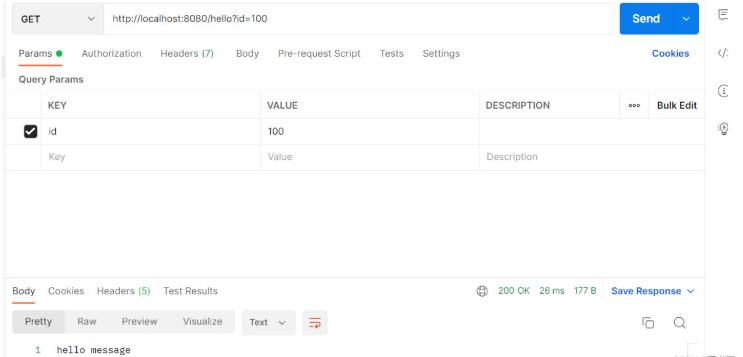
@RequestParam用来处理Content-Type 为 application/x-www-form-undencoded编码的内容,Content-Type 默认为该属性
@RequestParam也可用于其它类型的请求,例如:POST、DELETE等请求。
POST请求
由于@RequestParam是用来处理 Content-Type 为 application/x-www-form-urlencoded 编码的内容的,所以在postman中,要选择body的类型为 x-www-form-urlencoded,这样在headers中就自动变为了 Content-Type : application/x-www-form-urlencoded 编码格式。如下图所示:
@PostMapping("/save")
public String hello(@RequestParam(name = "id") Long id,
@RequestParam("name") String name,
@RequestParam("password") String password){
System.out.println(user);
return "hello message";
}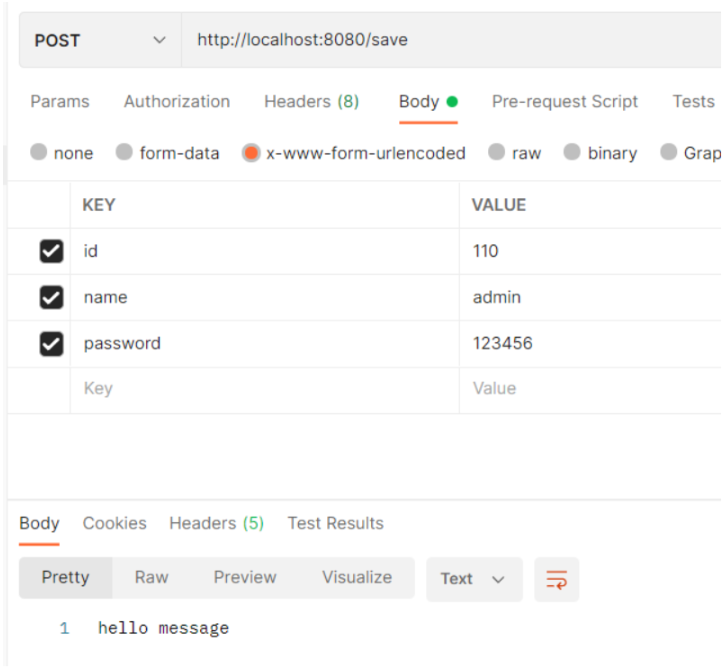
如果前台传递过来的参数不是三个,而是十个,如果继续使用 @RequestParam 的方式来接收请求参数,就需要十个 @RequestParam ,我们的代码可读性将会变得很差,并且当参数类型相同时,十分容易出错。所以使用实体类来接收传递过来的参数,但是 @RequestParam 不支持直接传递实体类的方式
@Data
public class User {
@NotNull(message = "id不能为空")
private Long id;
@NotBlank(message = "名字不能为空")
private String name;
@NotBlank(message = "密码不能为空")
private String password;
}// @RequestParam 不支持直接传递实体类的方式,所以可以在实体类中做数据校验,使用 @Validated 注解使得作用在实体类属性上的注解生效
@PostMapping("/save")
public String save(@Validated User user){
System.out.println(user);
return "hello success";
}
// console result: User(id=110, name=admin, password=123456)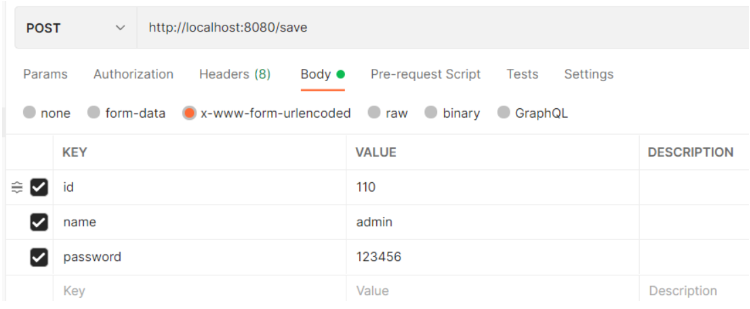
如果改用 json 字符串来传值的话,类型设置为 application/json,点击发送的话,会报错,后台接收不到值,为 null

// console result: User(id=null, name=null, password=null)
@RequestBody
注解@RequestBody接收的参数是来自requestBody中,即请求体。一般用于处理非 Content-Type: application/x-www-form-urlencoded编码格式的数据,比如:application/json、application/xml等类型的数据。
就application/json类型的数据而言,使用注解@RequestBody可以将body里面所有的json数据传到后端,后端再进行解析。
@PostMapping("/saveBatch")
public String saveBatch(@RequestBody @Validated List<User> list){
list.forEach(System.out::println);
return "saveBatch success";
}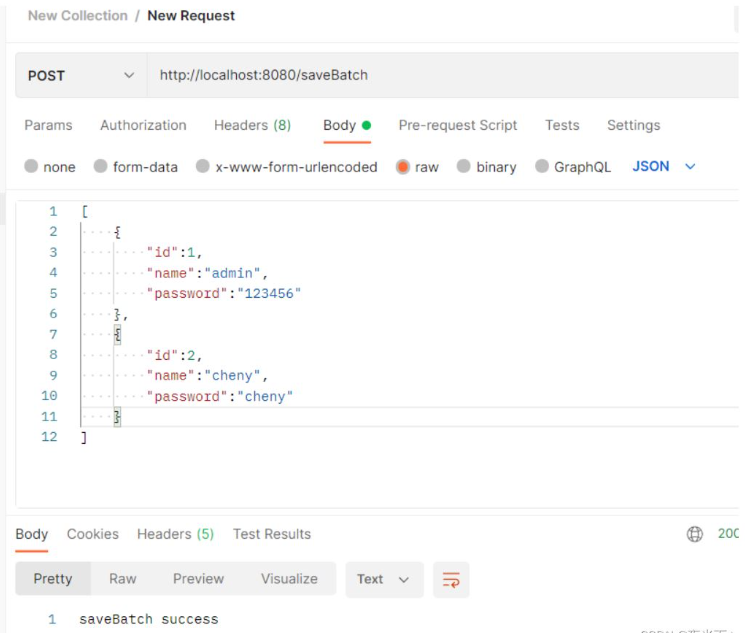
// console result:
// User(id=1, name=admin, password=123456)
// User(id=2, name=cheny, password=cheny)
传递到 Map 中
@PostMapping("/listMap")
public String saveMap(@RequestBody List<Map<String, String>> listMap){
for (Map<String, String> map : listMap) {
System.out.println(map);
}
return "listMap success";
}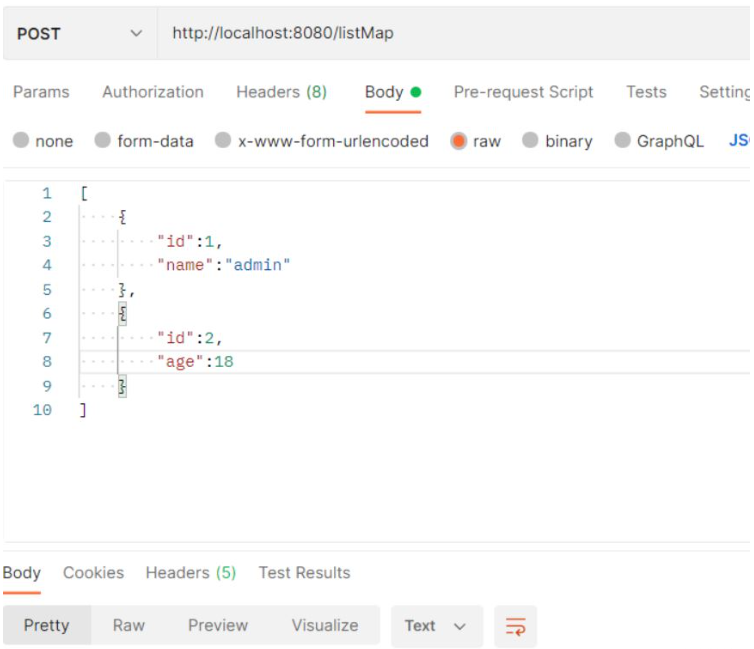
// console result:
// {id=1, name=admin}
// {id=2, age=18}感谢各位的阅读,以上就是“@RequestBody和@RequestParam注解如何使用”的内容了,经过本文的学习后,相信大家对@RequestBody和@RequestParam注解如何使用这一问题有了更深刻的体会,具体使用情况还需要大家实践验证。这里是捷杰建站,小编将为大家推送更多相关知识点的文章,欢迎关注!